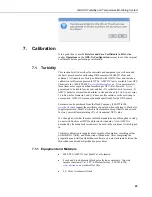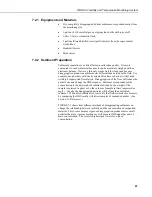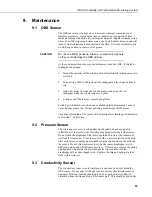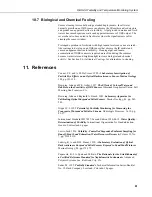
OBS-3A Turbidity and Temperature Monitoring System
during surveys or after each deployment. A sensor that has been stored dry
should be soaked in water for 15 minutes prior to use.
If the sensor becomes fouled with sediment, oil, or biological material,
conductivity will decline over a period of time indicating cleaning is necessary.
If a water jet fails to remove contaminants, the sensor can be flushed with hot
soapy water or warm alcohol. Do not use solvents. The last step in the
cleaning process should always be to flush with clean water.
9.4 Batteries
The unit runs on three D-size alkaline batteries. Buy the expensive ones with
the most distant pull date (“use before May 2012”). With all sensors installed,
the OBS-3A will run 400 hours in survey mode and for as long as 8000 hours
in one of the logging modes.
Always put OBS-3A to sleep when it will not be used for a
while to conserve battery capacity (see Section 6.12,
Shutdown
).
CAUTION
Refer to FIGURE 6-2
for installing batteries. Put the unit on a padded surface
and remove the three screws from the end with the handlebar using the 5/64 in.
hex wrench provided in the spares kit. Grasp the handlebar, turn the sensor end
up and pull the cap straight out of the pressure-housing tube. Immediately
wipe up any water from inside the tube. Stand the unit up on the sensor end
and remove the desiccant bags. Slide the clip away from the batteries until the
spent cells pop up and can be slid out of the tube. Insert fresh batteries in the
tube with the positive terminal (+) up. Press them down and slide the clip over
the batteries until it contacts the tube wall. Replenish the desiccant bags and
clean and regrease the O-ring. Replace the end cap.
Do not over tighten the screws.
CAUTION
Battery life will depend on the percentage of time the unit is sampling.
TABLE 9-1 shows battery life as a function of sample duration and interval to
assist with planning your setup. Pick a power-efficient sampling schedule that
meets your scientific objectives.
TABLE 9-1. Battery Life (Hours)
Interval
10
1
60
2
60
1
120
2
120
1
256
3
256
1
1024
3
(Sec.)
100%
50%
100%
50%
100%
10%
100%
10%
60
1300
NO
NO
NO
NO
NO
NO
NO
600
> 8000
5450
2080
3150
1100
1460
530
NO
900
> 8000
> 8000
2970
5450
1600
2110
785
NO
1800
> 8000
> 8000
5160
> 8000
2950
3815
1510
1120
3600
> 8000
> 8000
> 8000
> 8000
5150
6400
2810
2110
Duration in seconds (% Power)
NO = Not possible; 1 = All sensors; 2 = OBS & depth sensors; 3 = Wave calculations.
54

























